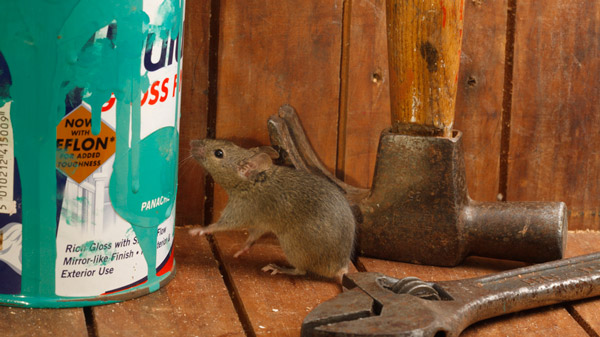Mice In The Home
By Chris Williams on December 31, 2013.

John Maher: Hi. My name’s John Maher. Today, I’m here with Tim Chace, an entomologist and and pest control technician at Colonial Pest, a pest control company serving eastern Massachusetts and southern New Hampshire and Maine. Today, we’re talking about mice in the home. Welcome, Tim.
Tim Chace: Thanks, John.
John: Tim, why do mice enter a home?
Tim: Mice enter your home to escape the climate and elements outside. As the temperature gets colder and colder, they are forced inside to escape the colder temperatures. Mice are susceptible to hypothermia and need to get inside to a warm location.
Mice are also escaping from predators, such as owls, hawks, and weasels, that would love to eat them at any point.
John: Do mice cause damage when they get into homes?
Tim: Certainly. Mice can cause damage to wiring, electrical appliances. They can move insulation around and chew holes in the structure that may cause weather damage and things like that.
John: Where do they tend to congregate in homes?
Tim: Mice can get in around garage doors typically, electrical appliances that are plugged in through the wall surfaces, chimney flashing and the roof ends.
John: How big of an opening does a mouse need in order to get into a home?
Tim: That’s a great question. Mice can get into very small openings, usually quarter inch, or larger. Typically the size of a number two pencil eraser are things where we start for mouse exclusion.
John: Well, can they actually squeeze into a space that small?
Tim: Mice are very, very tiny and squishy animals. They can actually get into anything that they will allow their nose to penetrate. So once he can get his nose into the opening, he is pretty much in. A mouse’s head is about the size of human pinky finger.
John: So what is it that you can do to prevent mice from getting into your home. Is there anything that you can do to seal up these little openings?
Tim: A lot can be done to seal up the opening. The first part of that would be a thorough inspection of the exterior of the structure looking for small openings and then a variety of materials can be used to seal up those openings such as copper mesh, caulking and other large items such as wood and general home repair.
John: What are signs that I have mice, what do mice feces look like, and what are some other signs that I might have mice?
Tim: Mice feces look like small black spindles approximately a centimeter in length. Mice pee or urinate and poop almost constantly. So you’ll find these little spindles in areas where mice commonly go.
John: When you come into a home and you are looking to see whether or not yes in fact this home has a mice problem, what are you looking for? Are you looking for those mice feces or…
Tim: We are looking for mouse feces, small drops of urine. They also have an oily gland on their neck area which secretes a little gray stain, so if you’ve had a lot of mouse activity, you can also find little runways where the stain is present and visible. That will give you a lot of information about where the mice are moving throughout the structure.
John: Tim, thanks very much for speaking with me.
Tim: You’re welcome, John.
John: For more information, you can visit the website at colonialpest.com, or call 1‑800‑525‑8084 for a free quote.